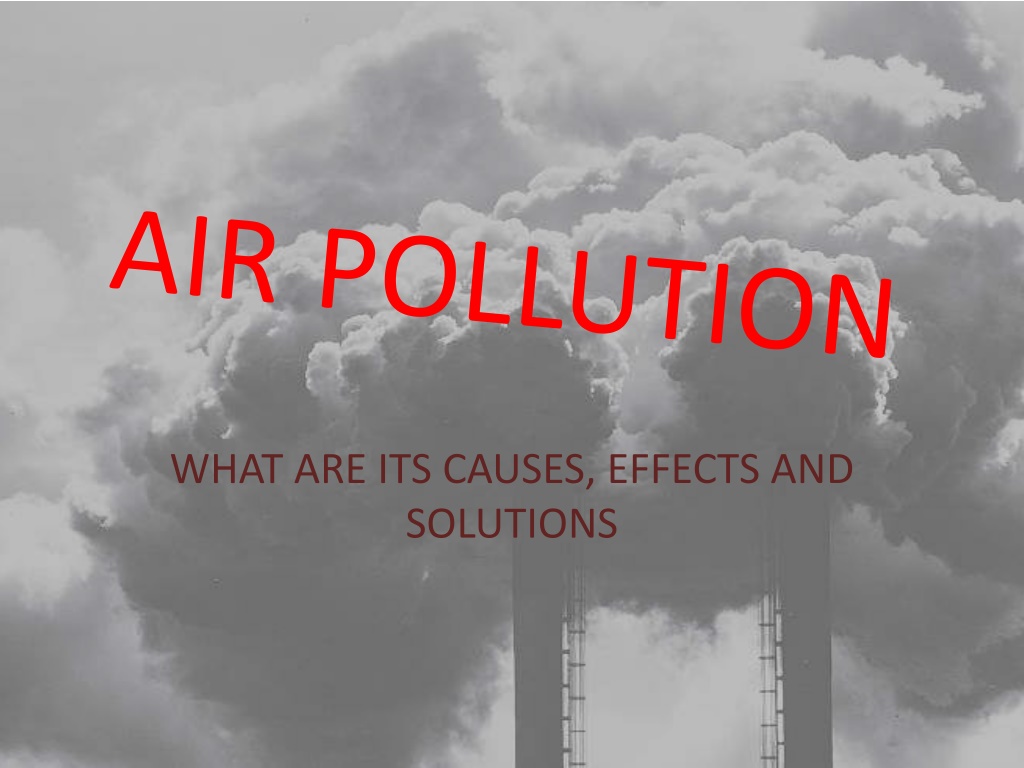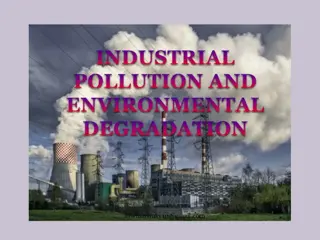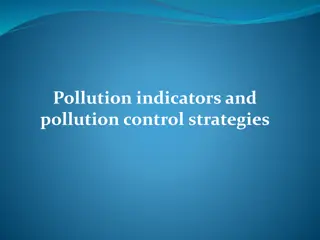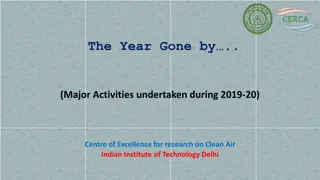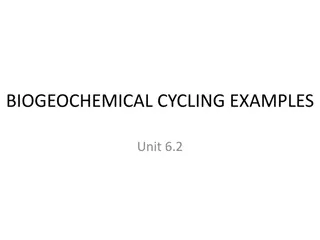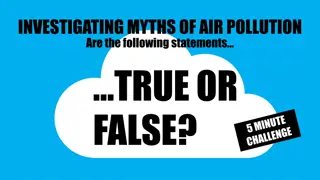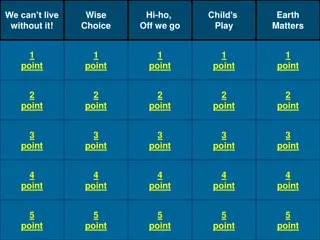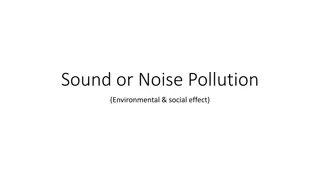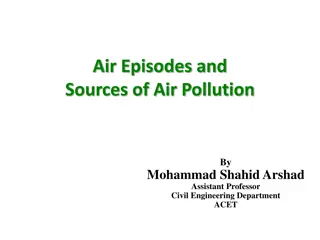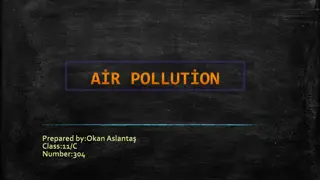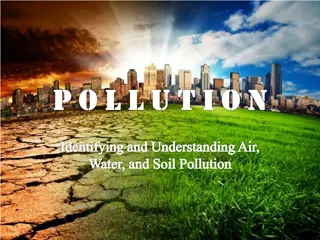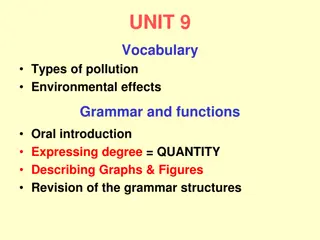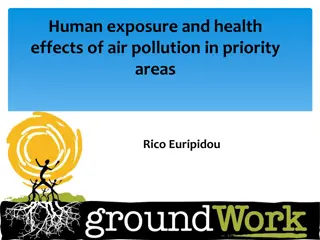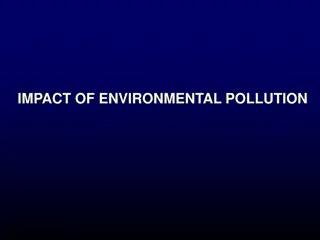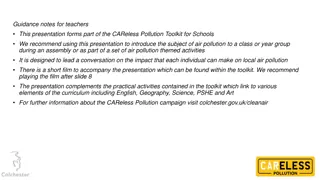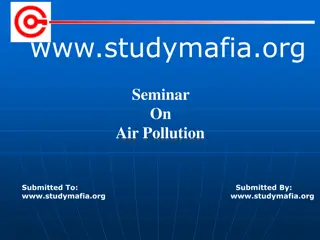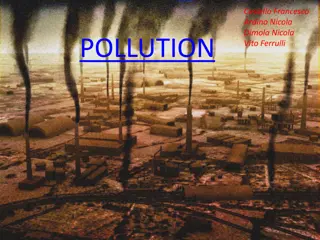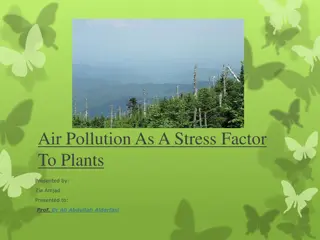Understanding Air Pollution: Causes, Effects, and Solutions
Pollution is the harmful introduction of contaminants into the environment, caused by human activities and natural disasters. It impacts all living organisms, making it challenging to sustain life. Air pollution, a major form of pollution, occurs when pollutants such as gases, dust particles, and fumes are released into the atmosphere, posing threats to humans, animals, and plants. This article delves into the causes, effects, and solutions of air pollution, highlighting sources like industrial emissions, fossil fuel combustion, and household chemicals.
Download Presentation

Please find below an Image/Link to download the presentation.
The content on the website is provided AS IS for your information and personal use only. It may not be sold, licensed, or shared on other websites without obtaining consent from the author. Download presentation by click this link. If you encounter any issues during the download, it is possible that the publisher has removed the file from their server.
E N D
Presentation Transcript
WHAT ARE ITS CAUSES, EFFECTS AND SOLUTIONS
IN GENERAL, WHAT IS POLLUTION? Pollution is the introduction of a contaminant into the environment. It is created mostly by human actions, but can also be a result of natural disasters. Pollution has a detrimental effect on any living organism in environment, making it virtually impossible to sustain life.
FORMS OF POLLUTION The realise of chemical, biological, physical or radiocative substances in the environment is called pollution. Among the main kinds of pollution are: soil contamination: mainly due to human activities that cause an imbalance in the natural soil environment. The dumping of industrial waste, landfills and the use of harmful chemicals can all lead to soil pollution. air pollution: due to release of chemicals and particulates such as nitrogen oxides that create smog and hydrocarbons. Industry and motor vehicles are responsible for the production of nitrogen oxides. water pollution: caused by industrial waste, agricultural drainage and sewage. radioactive conamination: caused by accidents happening in nuclear power stations and by the production and use of nuclear weapons. noise production: including roadway, aircraft and industrial noise and high- intensity sonars. light pollution: including light trespass and over-illumination. visual pollution: referring to the presence of overhead power lines, motorway billboards or open storage of junk and municipal solid waste.
WHAT IS AIR POLLUTION? Air pollution occurs when gases, dust particles, fumes (or smoke) or odour are introduced into the atmosphere in a way that makes it harmful to humans, animals and plant. This is because the air becomes dirty. Things that pollute the air are called pollutants; there are two types of pollutant: PRIMARY POLLUTANTS are those gases or particles that are pumped into the air to make it unclean. They include carbon monoxide from cars. SECONDARY POLLUTANTS: when pollutants in the air mix up in a chemical reaction, they form an even more dangerous chemical.
CAUSES EFFECTS AIR POLLUTION SOLUTIONS
CAUSES Human activities that result in air pollution include: Emissions from industries and manifacturing activities: in the manifacturing company there are long tubes erected high into the air, whit lots of smoke and fumes coming out of it. Waste incinerators, manifactuing industries and power plants emit high levels of carbon monoxide and chemicals into the air. This happens almost everywhere that people live. Petroleum refineries also release lots of hydrocarbons into the air. Burning fossil fuels: after the industrial age, trasportation has become a key part of our livels. Cars and heavy vehicles burn lots of fossil fuels to work. Emissions from automobile engines contain both primary and secondary pollutants. This is a mayor cause of pollution, and one that is very difficult to manage. Household and farming chemicals: crop dusting, fumigating homes, household cleaning products or painting supplies, over the counter insect/pest killers, fertilizer dust emit harmful chemicals into the air cause pollution. In many case, when we use these chemicals at home or officies with no or little ventilation, we may fall ill if we breathe them.
EFFECTS Acidification: Chemical reactions involving air pollutants can create acidic compounds which can cause harm to vegetation and buildings. Sometimes, when an air pollutant, for example acid combines with the water droplets that make up clouds, the water droplets become acidic, forming acid rain. When acid rain falls over an area, it can kill trees and harm animals, fish, and other wildlife. Acid rain destroys the level of plants. When acid rain infiltrates into soils, it changes the chemistry of the soil making it unfit for many living things that rely on soil as a habitat or for nutrition Ground-level ozone: chemical reactions insolving air pollutants create a poisonous gas ozone. Gas ozone can affect people s health and can damage vegetation types and some animal life too.
SOLUTIONS Solution efforts on pollution is always a big problem. This is becouse prevention interventions are always a better way of controlling air pollution. These prevention metods can either come from government or by individual actions. In many big cities, monitoring equipment have been installed at many points in the city. gouvernament encourage your family to use the bus, train or bike when commutin. If we all do this, there will be less cars on road and less fumes. Use energy wisely. This is because lots of ossil fuels are burned to generate electricity, and so if we can cut down the use, we will also cut down the amount of pollution we create. Recycle and re-use things. This will minimize the dependence of producing new things. Remember manifacturing industries create a lot of pollution, so if we can re-use thongs like shopping plastic bags, clothing, paper and bottles, it can help.
